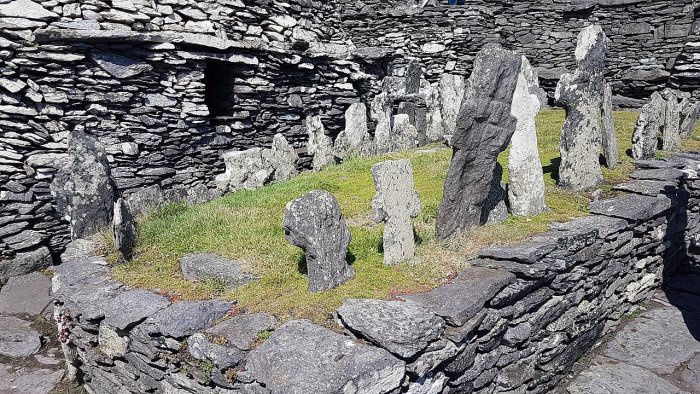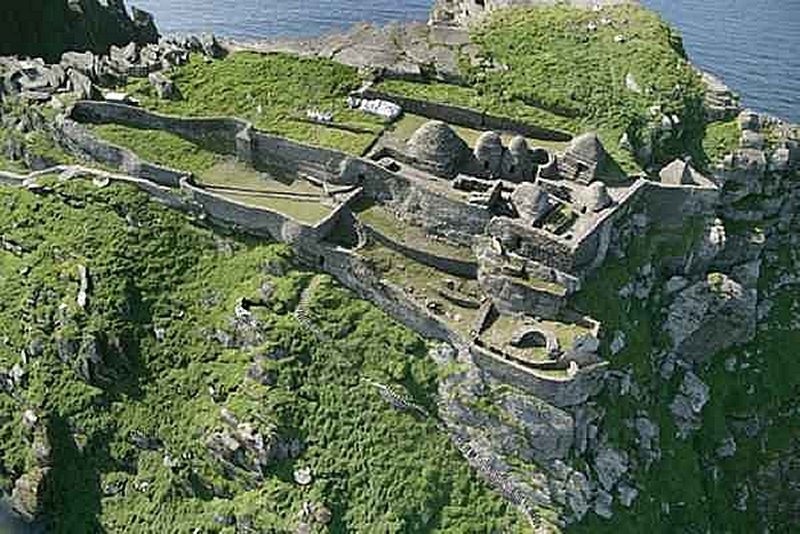Magnificent Skellig Michael And A 1,400-Year Old Christian Monastery
A. Sutherland - AncientPages.om - The magnificent Skellig Islands lie 8 miles (12 km) off the coast of Portmagee in South West Kerry. Rising majestically from the sea, Skellig Michael (or Great Skellig, one of the two Skellig Islands) towers 714ft (218 meters) above sea level.
The island's name is taken from the Irish language and means Michael's Rock. On the summit of this fantastic rock is a remarkably well-preserved 1,400-year-old Christian monastery, but it is not easy to visit Skellig Michael.
It is believed that the monastery was established in the 7th century on an island uninhabited earlier. Skelligs rocks are 350 million years old, dating from the Devonian Period; the area is remote and highly inaccessible.
The monastery, within an inner and outer enclosure, is situated on the sloping rock plateau at the northeastern summit. But despite the altitude, the location was perfectly chosen because it provided shelter and water collection: moreover, stone material was abundant, which enabled the building of the monastery.
 The drystone buildings on Skellig Michael were all corbelled. In this way, the interior space reduces as it rises up to form a dome-like structure. All the stones are positioned so that they slope outwards allowing for wind-borne rain to run off and so keep the building watertight. Credits: World Heritage Ireland
The drystone buildings on Skellig Michael were all corbelled. In this way, the interior space reduces as it rises up to form a dome-like structure. All the stones are positioned so that they slope outwards allowing for wind-borne rain to run off and so keep the building watertight. Credits: World Heritage Ireland
The early Irish Christian monks lived their Spartan life there until the 12th or 13th century in harsh conditions. Their life was undoubtedly more than difficult; during this time, the climate around Skellig Michael became colder and more prone to furious storms.
The remarkably well-preserved monastic enclosure of Skellig Michael is located 15 m (50 ft) below the northern peak on a long narrow terrace.
The central monastic area contains six beehive-shaped structures or huts called 'clochans,' the early traditional inverted boat-shaped oratory, and the medieval St. Michael's Church.
Other raised platforms contain incised crosses, cross-slabs, and the monk's graveyard with 22 early grave slabs. The gravestones have remained in their original positions.
The Monks Graveyard. The monastery at Skellig Michael. Image credit: Stinglehammer - CC BY-SA 4.0
The larger oratory, internally about 2.3 m (7.5 ft) high, has a white quartz cross, a later addition, set into the stones above the door on the outside.
The largest of the beehive huts were more sturdily built, 5 m (16.4 ft) high, with walls 1.8m (6 ft) thick at its base, with two cupboards and a double-lintelled door. Another, smaller oratory of later date stands on a northeastern shelf above the cliffs, with the boat landing far below.
The monastery was terraced due to the sheer sites of the Skelligs rocks. The lower terraces within the outer enclosure functioned as garden areas (for example, the Monks' Garden) for cultivation.
The monks constructed three sets of steps to their monastery, affording access during differing weather conditions. These are known as the East, South, and North Steps.
Skellig Michael (Sceilg Mhichíl) Monastery, Image credit: https://www.worldheritageireland.ie/
Only the South Steps are accessible to the public today. The South and North Steps meet at Christ's Saddle, the only reasonably flat part of the island, and continue as one as far as the monastery.
There were probably never more than a dozen monks on the island at any one time, plus an abbot. It must indeed have been a very lonesome existence for the monks, despite the faith which initiated their decision to move there.
The monks' graveyard is located to the east of the Large Oratory. The series of crosses set into the west side are in their original locations. These crosses are roughly shaped, and some have plain incised decorations.
Clocháns; dry-stone huts with a corbel roofs. Image credit: Towel401 - CC BY-SA 4.0
Why the monks decided to build a monastery in such a remote and inaccessible place remains unknown. One possibility is they tried to escape Viking raids, and the monastic settlement on Great Skellig became the sanctuary of last resort.
The monastery survived several Viking raids in the 9th century, notably in 823 A.D. It was later significantly expanded with a new chapel built around 1000 A.D.
Sometime in the 12th century, the monks abandoned Skellig Michael and moved to the Augustinian Monastery at Ballinskelligs, near Waterville in County Kerry on the mainland.
Copyright © AncientPages.com All rights reserved. This material may not be published, broadcast, rewritten or redistributed in whole or part without the express written permission of AncientPages.com
Expand for referencesMore From Ancient Pages
-
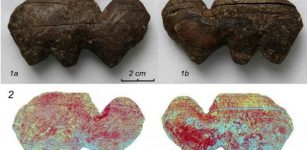 Ancient Mammoth Ivory Carving Technology Of Master Craftsmen – Reconstructed
Archaeology | Aug 27, 2020
Ancient Mammoth Ivory Carving Technology Of Master Craftsmen – Reconstructed
Archaeology | Aug 27, 2020 -
 Unusual 6,000-Year-Old Gold Objects Discovered In Hungarian Tombs – More Mysterious Conical Hats?
Archaeology | Mar 25, 2021
Unusual 6,000-Year-Old Gold Objects Discovered In Hungarian Tombs – More Mysterious Conical Hats?
Archaeology | Mar 25, 2021 -
 Political Debates In Ancient Rome: Great Harshness, Personal Attacks And Unpleasant Atmosphere
Archaeology | Aug 29, 2018
Political Debates In Ancient Rome: Great Harshness, Personal Attacks And Unpleasant Atmosphere
Archaeology | Aug 29, 2018 -
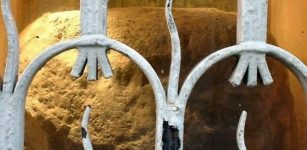 Legendary And Mysterious Stone Of Brutus – The London Stone Refuses To Give Up Its Secrets
Artifacts | Jan 21, 2022
Legendary And Mysterious Stone Of Brutus – The London Stone Refuses To Give Up Its Secrets
Artifacts | Jan 21, 2022 -
 Lady Trieu: Fierce Warrior, Rebel, Freedom Fighter And National Hero In Vietnam
Featured Stories | Feb 26, 2019
Lady Trieu: Fierce Warrior, Rebel, Freedom Fighter And National Hero In Vietnam
Featured Stories | Feb 26, 2019 -
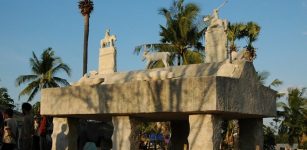 Thousands Of Remarkable Megaliths On The Sumba Island
Featured Stories | Aug 30, 2017
Thousands Of Remarkable Megaliths On The Sumba Island
Featured Stories | Aug 30, 2017 -
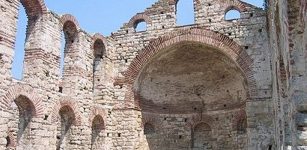 Ancient Nessebar – 3,000-Year-Old History Of Many Civilizations
Featured Stories | Jan 10, 2016
Ancient Nessebar – 3,000-Year-Old History Of Many Civilizations
Featured Stories | Jan 10, 2016 -
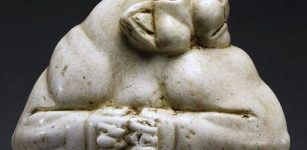 Amazing ‘Guennol Lioness’ – One Of The Greatest Ancient Works Of Art Of All Time
Artifacts | Sep 6, 2018
Amazing ‘Guennol Lioness’ – One Of The Greatest Ancient Works Of Art Of All Time
Artifacts | Sep 6, 2018 -
 Mystery Of Queen Semiramis: Famous And Powerful Ancient Ruler And Warrior Queen
Featured Stories | Feb 15, 2018
Mystery Of Queen Semiramis: Famous And Powerful Ancient Ruler And Warrior Queen
Featured Stories | Feb 15, 2018 -
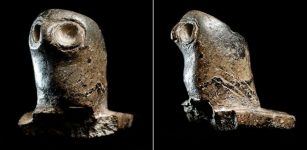 Enigmatic 2,000 -Years-Old Carved Stone Owl Pipes – An Ancient Unsolved Secret Of Illinois
Artifacts | Oct 4, 2018
Enigmatic 2,000 -Years-Old Carved Stone Owl Pipes – An Ancient Unsolved Secret Of Illinois
Artifacts | Oct 4, 2018 -
 Great Pyramid of Cholula Is The Largest In The World Today
Ancient History Facts | Feb 9, 2016
Great Pyramid of Cholula Is The Largest In The World Today
Ancient History Facts | Feb 9, 2016 -
 Secret Tunnels Used By Knights Templar Leading To The Treasure Tower – Discovered
Archaeology | Oct 29, 2019
Secret Tunnels Used By Knights Templar Leading To The Treasure Tower – Discovered
Archaeology | Oct 29, 2019 -
 Decebalus – The Brave One’ – Last Mighty King Of Dacian People
Featured Stories | Jun 23, 2022
Decebalus – The Brave One’ – Last Mighty King Of Dacian People
Featured Stories | Jun 23, 2022 -
 Chonchon ‘Tue Tue’ Bird With Human Head Brought Bad Omens To Places It Haunted In Beliefs Of Mapuche Indians
Featured Stories | Mar 12, 2024
Chonchon ‘Tue Tue’ Bird With Human Head Brought Bad Omens To Places It Haunted In Beliefs Of Mapuche Indians
Featured Stories | Mar 12, 2024 -
 Trolls – Fascinating Mythical Creatures Of Scandinavia
Featured Stories | Jun 13, 2022
Trolls – Fascinating Mythical Creatures Of Scandinavia
Featured Stories | Jun 13, 2022 -
 Ancient DNA And Tombstones Lead Scientists To Black Death’s Source Strain
Archaeology | Jun 15, 2022
Ancient DNA And Tombstones Lead Scientists To Black Death’s Source Strain
Archaeology | Jun 15, 2022 -
 On This Day In History: Twelfth Council Of Toledo Initiated By King Erwig – On Jan 9, 681
News | Jan 9, 2017
On This Day In History: Twelfth Council Of Toledo Initiated By King Erwig – On Jan 9, 681
News | Jan 9, 2017 -
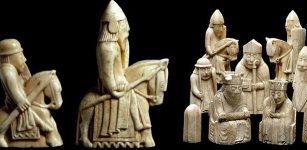 Mystery Of The Beautiful Viking Uig Chessmen Found On The Isle Of Lewis, Scotland
Artifacts | Dec 14, 2015
Mystery Of The Beautiful Viking Uig Chessmen Found On The Isle Of Lewis, Scotland
Artifacts | Dec 14, 2015 -
 Notre Dame Is On Fire! Can The Magnificent Cathedral Still Be Saved?
News | Apr 15, 2019
Notre Dame Is On Fire! Can The Magnificent Cathedral Still Be Saved?
News | Apr 15, 2019 -
 On This Day In History: Papal Bull Issued To Arrest All Knights Templar And Seize Their Lands – On 22 Nov, 1307
News | Nov 22, 2016
On This Day In History: Papal Bull Issued To Arrest All Knights Templar And Seize Their Lands – On 22 Nov, 1307
News | Nov 22, 2016


